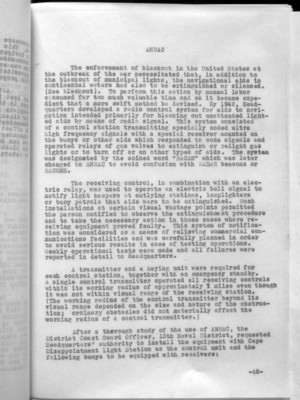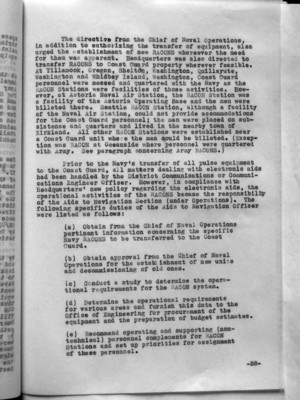Pages That Mention Communications
Coast Guard District narrative histories 1945
65
The enforcement of blackout in the United States at the outbreak of the war necessitated that, in addition to the blackout of municipal lights, the navigational aids in continental waters had also to be extinguished or silenced. (See blackout). To perform this action by manual labor consumed far too much valuable time and so it became expedient that a more swift method be devised. By 1942, Headquarters developed a radio control system for aids to navigation intended primarily for blacking out unattended lighted aids by means of radio signal. This system consisted of a control station transmitting specially coded ultra high frequency signals with a special receiver mounted on the buoys or other aids which responded to code signals and operated relays of gas valves to extinguish or relight gas lights or to turn off or on other types of aids. The system was designated by the coined word "RACAN" which was later changed to ANRAC to avoid confusion with RADAR beacons or RACONS.
The receiving control, in combination with an electric relay, was used to operate an electric bell signal to notify light keepers at outlying stations, lamplighters or buoy patrols that aids were to be extinguished. Such installations at certain visual vantage points permitted the person notified to observe the extinguishment procedure and to take the necessary action in those cases where receiving equipment proved faulty. This system of notification was considered as a means of relieving commercial communications facilities and was carefully planned in order to avoid serious results in case of testing operations. Weekly operational tests were made and all failures were reported in detail to Headquarters.
A transmitter and a keying unit were required for each control station, together with an emergency standby. A single control transmitter operated all receiving controls within its working radius of approximately 7 miles even though it was not within visual range of the receiving station. (The working radius of the control transmitter beyond its visual range depended on the size and nature of the obstruction; ordinary obstacles did not materially affect the working radius of a control transmitter.)
After a thorough study of the use of ANRAC, the District Coast Guard Officer, 13th Naval District, requested Headquarters' authority to install the equipment with Cape Disappointment Light Station as the control unit and the following buoys to be equipped with receivers:
-45-
78
The directive from the Chief of Naval Operations, in addition to authorizing the transfer of equipment, also urged the establishment of new RACONS wherever the need for them was apparent. Headquarters was also directed to transfer RACONS to Coast Guard property wherever feasible. At Tillamook, Oregon, Shelton, Washington, Coast Guard personnel were messed and quartered with the Navy as the RACON Stations were facilities of those activities. However, at Astoria Naval Air Station, the RACON Station was a facility of the Astoria Operating Base and the men were billeted there. Seattle RACON Station, although a facility of the Naval Air Station, could not provide accommodations for the Coast Guard personnel; the men were placed on subsistence and quarters and lived in the nearby town of Kirkland. All other RACON Stations were established near a Coast Guard unit where the men could be billeted. (Exception was RACON at Oceanside where personnel were quartered with Army. See paragraph concerning Army RACONS.)
Prior to the Navy's transfer of all pulse equipment to the Coast Guard, all matters dealing with electronic aids had been handled by the District Communications or Communications Engineer Officer. However, in compliance with Headquarters' new policy regarding the electronic aids, the operational activities of the RACONS became the responsibility of the Aids to Navigation Section (under Operations). The following specific duties of the Aids to Navigation Officer were listed as follows:
(a) Obtain from the Chief of Naval Operations pertinent information concerning the specific Navy RACONS to be transferred to the Coast Guard.
(b) Obtain approval form the Chief of Naval Operations for the establishment of new units and decommissioning of old ones.
(c) Conduct a study to determine the operational requirements for the RACON system.
(d) Determine the operational requirements for various areas and furnish this data to the Office of Engineering for procurement of the equipment and the preparation of budget estimates.
(e) Recommend operating and supporting (non-technical) personnel complements for RACON Stations and set up priorities for assignment of these personnel.
-58-

